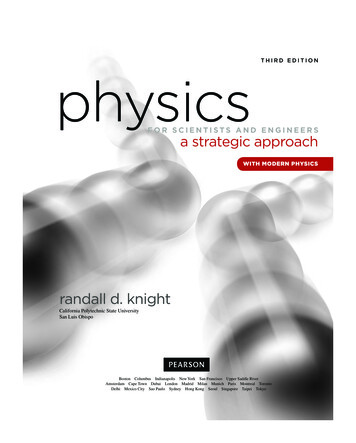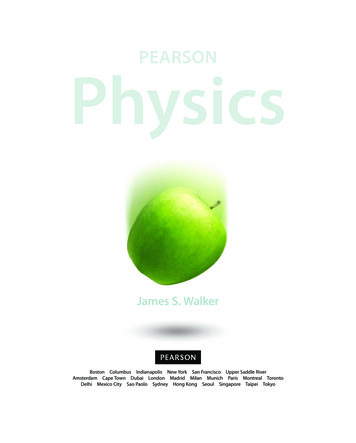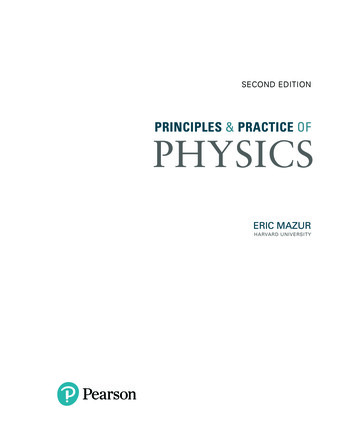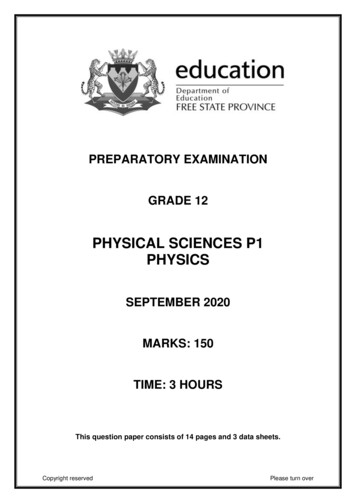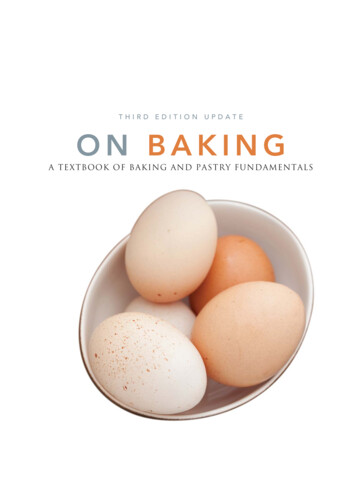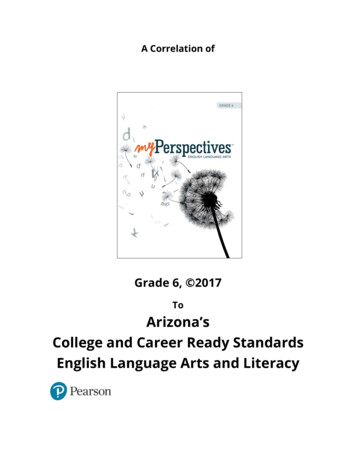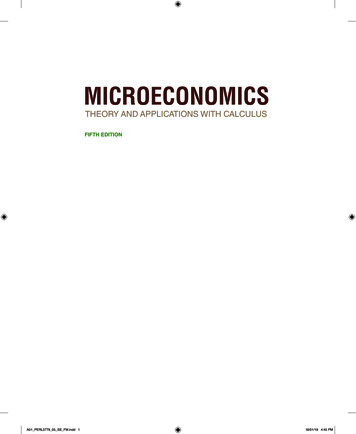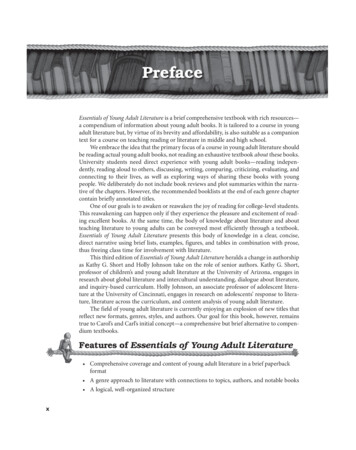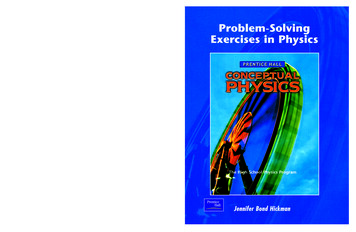
Transcription
Exercises in PhysicsJennifer Bond HickmanNeedham, MassachusettsUpper Saddle River, New JerseyGlenview, Illinois
To my grandfather, C. Lawrence BondWhen I was 10 years old, you paid me 10 to write a book for you.I’ve finally finished it!Illustrations by Jennifer Bond Hickman.Cover Photograph: Motor Press Agent/Superstock, Inc.Many of the designations used by manufacturers and sellers to distinguishtheir products are claimed as trademarks. Where such a designation appearsin this book, and the publisher was aware of a trademark claim, thedesignations have been printed in initial caps (e.g., Macintosh).Copyright 2002 by Prentice-Hall, Inc., Upper Saddle River, New Jersey07458. All rights reserved. Printed in the United States of America. Thispublication is protected by copyright, and permission should be obtainedfrom the publisher prior to any prohibited reproduction, storage in a retrievalsystem, or transmission in any form or by any means, electronic, mechanical,photocopying, recording, or likewise. For information regardingpermission(s), write to: Rights and Permissions Department.ISBN 0-13-054275-X26 V031 13 12 11
ContentsPreface to Students:Welcome to Physics!iv1 Motion1-1 Speed, Velocity, andAcceleration1-2 Free Fall12 Vectors and Projectiles2-1 Vectors and Scalars2-2 Projectile Motion1515213 Forces3-1 Forces and Acceleration3-2 Friction3-3 Statics3-4 Pressure29293538444 Momentum4-1 Impulse and Momentum4-2 Conservation of Momentum5151555 Energy and Machines5-1 Work and Power5-2 Energy5-3 Machines and Efficiency636366726 Circular and Rotational Motion6-1 Centripetal Acceleration andForce6-2 Torque6-3 Moment of Inertia andAngular Momentum81188187917 Law of Universal Gravitation7-1 Gravitational Force7-2 Gravitational Acceleration7-3 Escape Speed97971011048 Special Relativity8-1 Time Dilation8-2 Relativistic Length andEnergy1091099 Solids, Liquids, and Gases9-1 Density9-2 Solids9-3 Liquids9-4 Gases11911912112413010 Temperature and Heat10-1 Temperature and Expansion10-2 Heat11313513514011 Simple Harmonic Motion11-1 Springs11-2 Pendulums14914915312 Waves and Sound12-1 Wave Motion12-2 Doppler Effect12-3 Standing Waves15915916116513 Reflection and Refraction13-1 The Speed of Light13-2 Reflection13-3 Refraction17117117317714 Lenses, Diffraction, andInterference14-1 Lenses, Telescopes, andMagnifying Glasses14-2 Eyeglasses14-3 Diffraction and Interference18318318919215 Electrostatics15-1 Electrostatic Force15-2 Electric Field15-3 Electrical PotentialDifference19719720016 Direct Current Circuits16-1 Current and Resistance16-2 Capacitance16-3 Power16-4 Series and Parallel Circuits20920921221421717 Magnetism and ElectromagneticInduction17-1 Magnetic Forces and Fields17-2 Electromagnetic Induction22522522718 Modern Physics18-1 The Atom and the Quantum18-2 The Photoelectric Effect18-3 Energy Level Diagrams18-4 Radioactivity233233236239241Appendix A: Working WithNumbersSignificant FiguresUnit ConversionsSome Simple TrigonometryRelationshipsSome Common PrefixesAppendix B: Selected Answers203247249iii
Welcome to Physics!Studying physics is exciting because it can help you answer many questionsabout how and why our world works. Your workbook is designed to takesome “real-life” situations and examine them with the use of equations, a taskoften referred to as problem solving. Problem solving, however, is more thanjust solving numerical exercises by doing calculations. Using mathematics isonly one way to obtain a solution. Another effective method of problemsolving involves drawing on conceptual understanding to explain how theworld works and applying those concepts in the laboratory. Like scientists, weperform experiments to test our hypotheses. Until we can understand theconcepts and have the opportunity to make our own discoveries, the numbersand equations of physics are meaningless. In the words of Paul G. Hewitt,author of Conceptual Physics, “Formulas [should be used] as guides tothinking. . . . We [must] learn to conceptualize before we learn to compute.”This book is not meant to stand alone. It is not meant to replace your physicstext, the laboratory work that you do, or your physics teacher. Its purpose isto reinforce the concepts that you have already learned in class and to giveyou the opportunity to try some calculations with your teacher’s help. If youhave had difficulty solving word problems in the past, rely on yourconceptual understanding of the physics to reason out what should behappening before beginning your mathematical solution. The procedureoutlined in the next section will lead you step-by-step through the exercisesand make learning to do simple computations a little easier.How to Use This BookAs you begin to use this book, you will discover that the word problem hasbeen replaced with the word exercise. A physics exercise does not reallybecome a problem until you accept the challenge it offers and attempt to solveit. Once you have chosen to make it your problem, you have a personalinterest in finding the solution.Each chapter of this workbook is divided into two or more topic sections thatbegin with some physics theory. This theory section provides a very briefreview of the concepts and equations your teacher has discussed in class, andis not an introduction to new material. It is presumed that you have alreadylearned everything in the theory section before beginning the exercises. Thisreview is simply a reminder and a place to find all the equations you need.Following the theory, there is a section called Solved Examples, where thetheory is applied to exercises similar to those you will be expected to solvelater. Solutions are organized to make it easy to follow a calculation frombeginning to end. Most solved examples are in the following format.iv
Given: States the known valuesin the exercise.Unknown: Lists the unknown you arelooking for.Original equation: Shows the equationin its original form.Solve: Shows the equation set up in terms of the unknown, substitutes thenumerical values, and solves for the unknown. The answer is thenwritten with the correct units and shown in boldface type for easyidentification.A section of Practice Exercises allows you to apply some of the skills you havelearned to new situations.For more practice, at the end of each chapter there is a section of AdditionalExercises, which require the same level of understanding as the PracticeExercises. The final section, called Challenge Exercises for Further Study,contains exercises requiring more complex calculations. Challenge Exercisesare intended for you to use after you have mastered the skills used in earlierexercises and are anxious to take on some more rigorous computations.At the end of the workbook, some Selected Answers will allow you to checkyour progress.Using the Right RecipeSolving physics exercises is much like baking a cake. The first time you try todo it, you must read the recipe very carefully and use exactly the ingredientslisted. The next time, you are a little less nervous about how well the cake willturn out. Pretty soon you can make the cake without having to read the recipeat all. You eventually become so comfortable making cakes that you are ableto experiment by adding ingredients in a different order or changing therecipe slightly to make the cake even better. When solving physics exercises,you will find it easy to follow the prescribed “recipe” shown in the SolvedExamples. After trying a few exercises, you will have started to develop astrategy for constructing your solution that you can retain throughout theentire book. As you get better and better at doing calculations and youdevelop a greater conceptual understanding of the physics involved, you mayeven come up with an alternative method of solving an exercise that isdifferent from the one used in this book. If so, congratulations! You have donejust what the physicist does when he or she tries to find a solution. Be sure toshow your teacher and classmates your alternative approach. It is valuable tolook at many different solutions to the same exercise.An Alternative to Counting on Your FingersEarly scientists had to make all of their calculations by hand. Later, the sliderule made calculations a little quicker. Today’s tool is the hand-held pocketcalculator. To save time, you are encouraged to do your calculations with theuse of a calculator, but be sure that you first understand why you are doingthem. Remember, it’s important to know how to operate without a calculatoras well. Many students rely so heavily on their calculator that they begin tolose the skill of doing calculations by hand. It is extremely important to beable to add, subtract, multiply, divide, and square numbers. You shouldv
practice working with exponents (called scientific notation) and estimatinganswers to the nearest power of ten because you may not always have acalculator handy!How Much is Too Much?When making measurements, you may have measurement tools that allowyou only a certain degree of precision. For example, you may be able tomeasure your friend’s height to the nearest millimeter, but estimating it anycloser is difficult. You may say his height is 1536 mm or, in other words,1.536 m. Since we don’t know what comes after the 6, we say that this numbercontains 4 significant figures. Each one can be accurately measured. Whenadding, subtracting, multiplying, and dividing numbers, it is important tokeep significant figures in mind. The invention of the calculator has made thistask difficult, because the calculator customarily carries out our calculations to8 figures or more, many of which are probably not significant. The rules forthe correct use of significant figures can be found in Appendix A. You willfind that all of the solved examples in this book and the selected answers inthe back adhere to these rules on significant figures and you should too,whenever possible.You Can’t Add Apples and OrangesWhen solving numerical exercises, it is always important to include theproper units with any number you are using. Not only will this help youdetermine the units in the final answer, but it will also help you with yournumerical solution as well. If the units in an exercise do not combine to givethe correct units in your final answer, then you may have made a mistake insetting up the original equation. In other words, using the correct units is away of double-checking all of your work.In this book we will use the units of the Système International (SI), the standardsystem of units in the physics community. Any units not written in the SIform should be converted to the SI system before beginning your calculations.See Appendix A for a review of some important prefixes that you will seewhen working in the SI system.A Word of ThanksI would like to thank the physics students at BostonUniversity Academy, Phillips Academy, and BelmontHigh School for their input in writing, editing andsolving exercises in this book.Finally, I give my heartfelt thanks to my husband, PaulHickman, for his countless hours proofreading, editing,and problem solving, and for his unending support andencouragement throughout my work on this book.vi
1Motion1-1 Speed, Velocity, and AccelerationSpeed vs. VelocityVocabularyDistance: How far something travels.VocabularyDisplacement: How far something travels in a given direction.Notice that these two terms are very similar. Distance is an example of whatwe call a scalar quantity. In other words, it has magnitude, but no direction.Displacement is an example of a vector quantity because it has bothmagnitude and direction.The SI (Système International) unit for distance and displacement is themeter (m).Displacements smaller than a meter may be expressed in units of centimeters(cm) or millimeters (mm). Displacements much larger than a meter may beexpressed in units of kilometers (km). See Appendix A for the meanings ofthese and other common prefixes.VocabularySpeed: How fast something is moving.average speed Vocabularydistance traveledelapsed timeorvav d tVelocity: How fast something is moving in a given direction.average velocity displacementelapsed timeorvav d df do ttf towhere df and tf are the final position and time respectively, and do and to arethe initial position and time. The symbol “ ” (delta) means “change” so d isthe change in position, or the displacement, while t is the change in time.In this book all vector quantities will be introduced in an equation with boldtype while all scalar quantities will be introduced in an equation in regulartype. Note that speed is a scalar quantity while velocity is a vector quantity.1
The SI unit for both speed and velocity is the meter per second (m/s).When traveling in any moving vehicle, you rarely maintain the same velocitythroughout an entire trip. If you did, you would travel at a constant speed ina straight line. Instead, speed and direction usually vary during your time oftravel.If you begin and end at the same location but you travel for a great distance ingetting there (for example, when you travel in a circle), you have a measurableaverage speed. However, since your total displacement for such a trip is zero,your average velocity is also zero. In this chapter, both average speed andaverage velocity will be written as vav. The “av” subscript will be dropped inlater chapters.AccelerationVocabularyAcceleration: The rate at which the velocity changes during a given amountof time.acceleration change in velocityelapsed timeora v vf vo ttf towhere the terms vf and vo mean final velocity and initial velocity, respectively.The SI unit for acceleration is the meter per second squared (m/s2).If the final velocity of a moving object is smaller than its initial velocity, theobject must be slowing down. A slowing object is sometimes said to havenegative acceleration because the magnitude of the acceleration is preceded by anegative sign.Solved ExamplesExample 1:Benjamin watches a thunderstorm fro
Appendix B: Selected Answers 249. iv Welcome to Physics! Studying physics is exciting because it can help you answer many questions about how and why our world works. Your workbook is designed to take some “real-life” situations and examine them with the use of equations, a task often referred to as problem solving.Problem solving, however, is more than just solving numerical exercises by .
